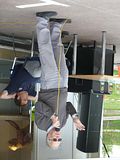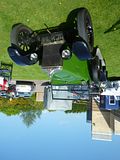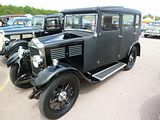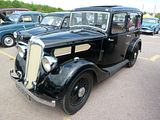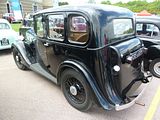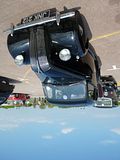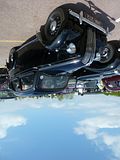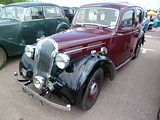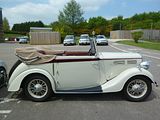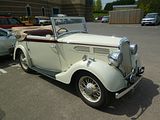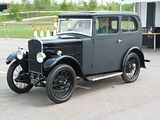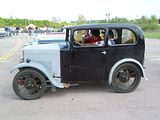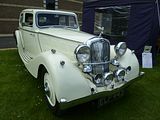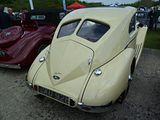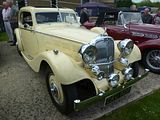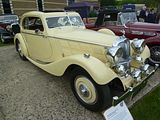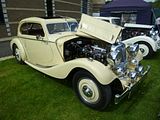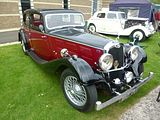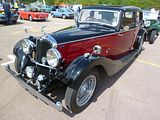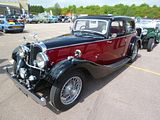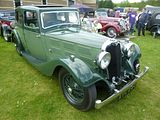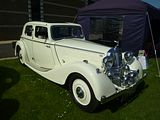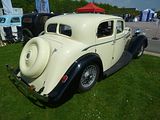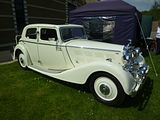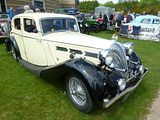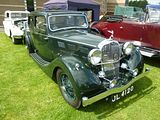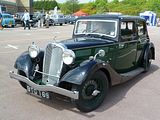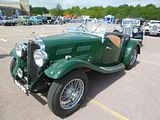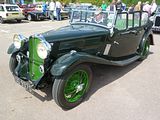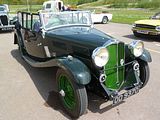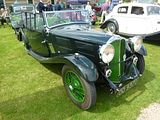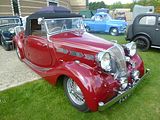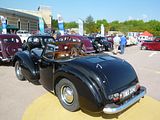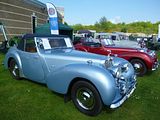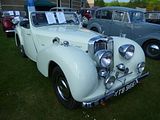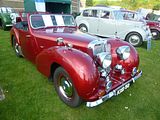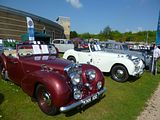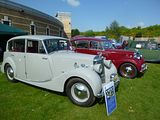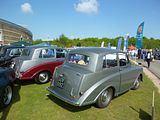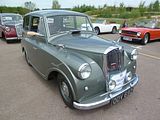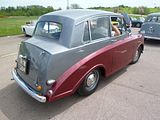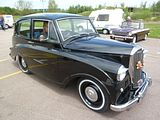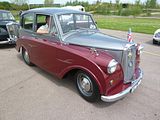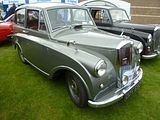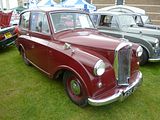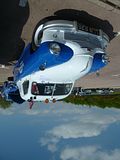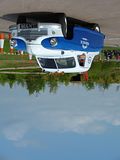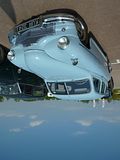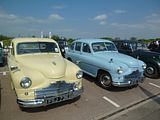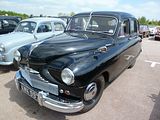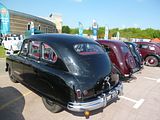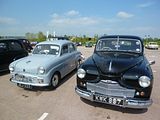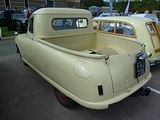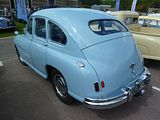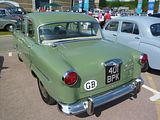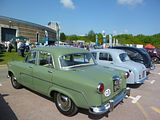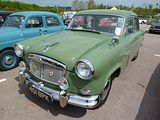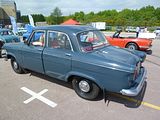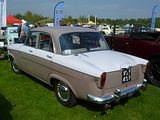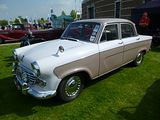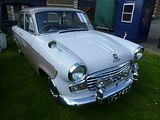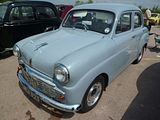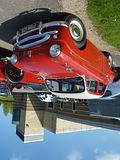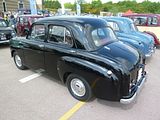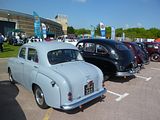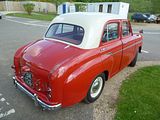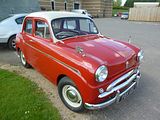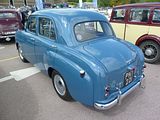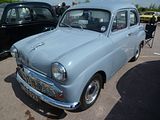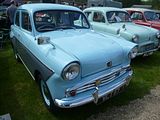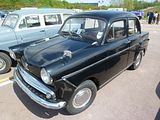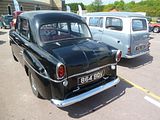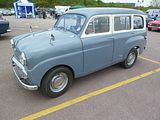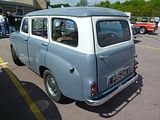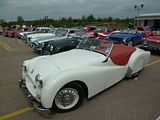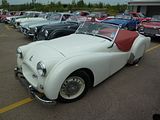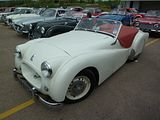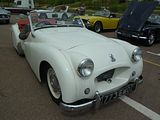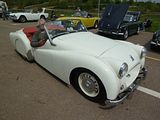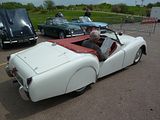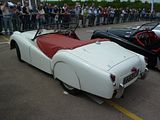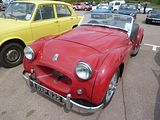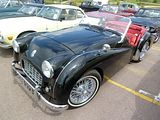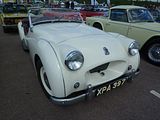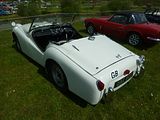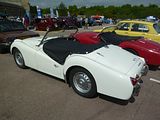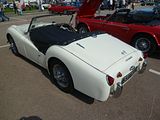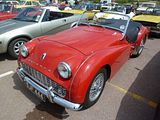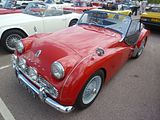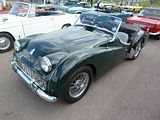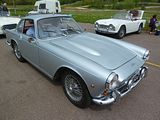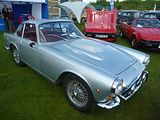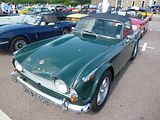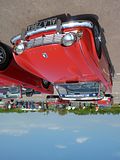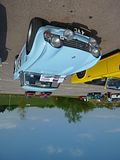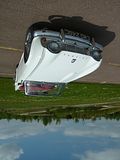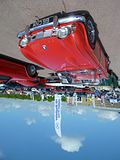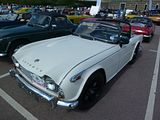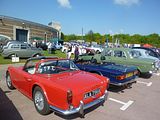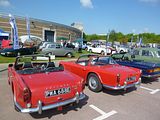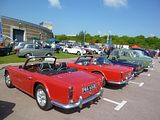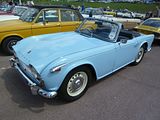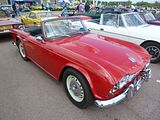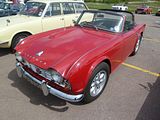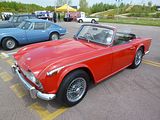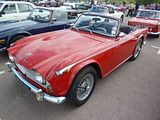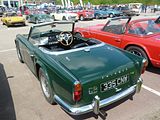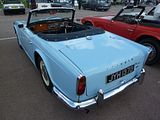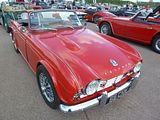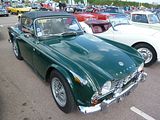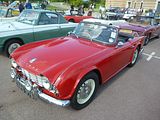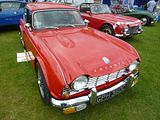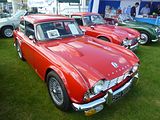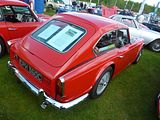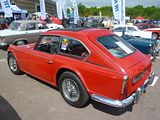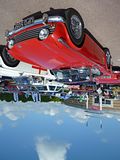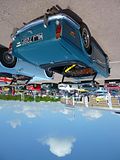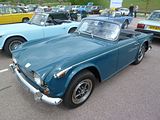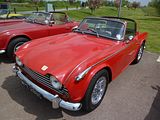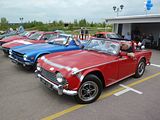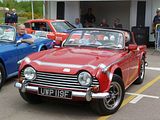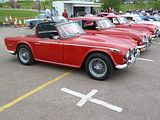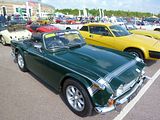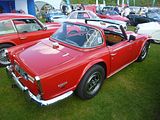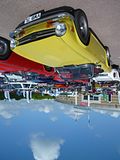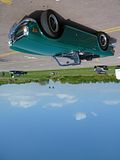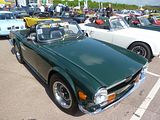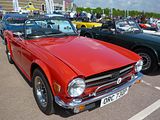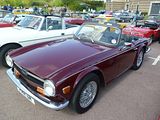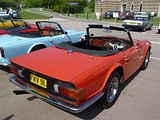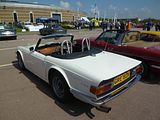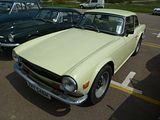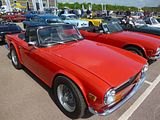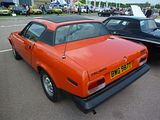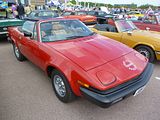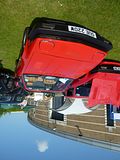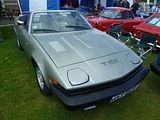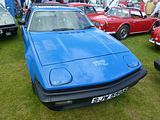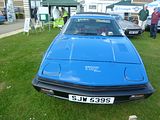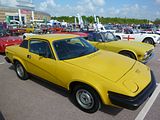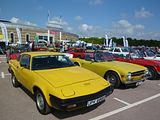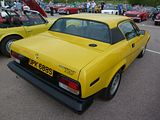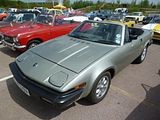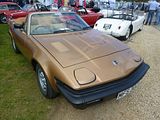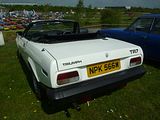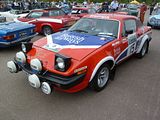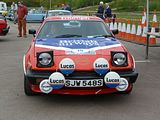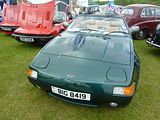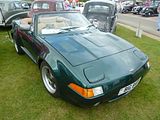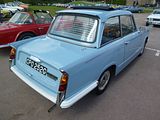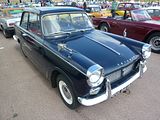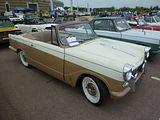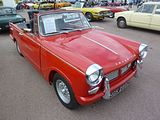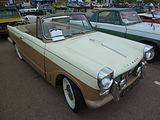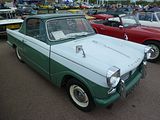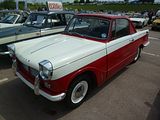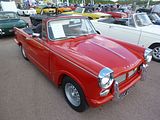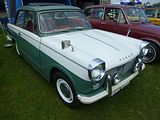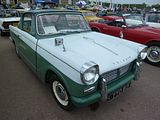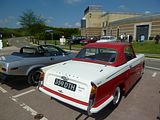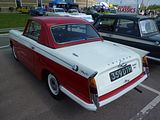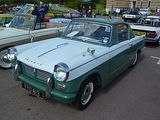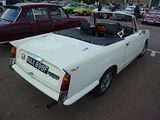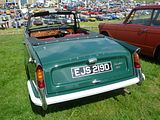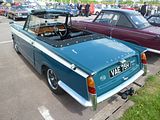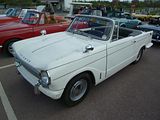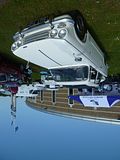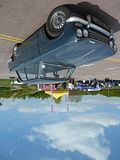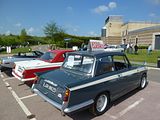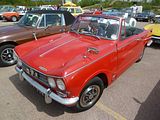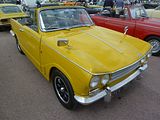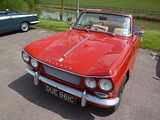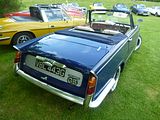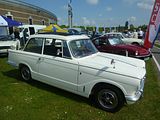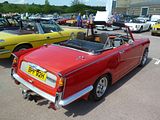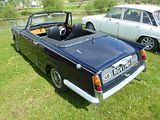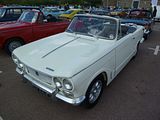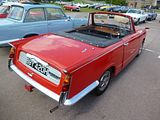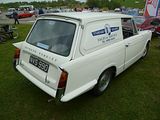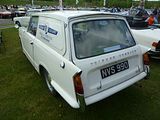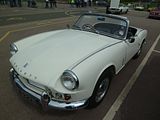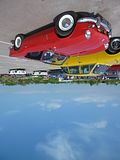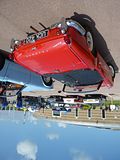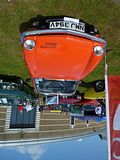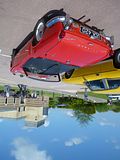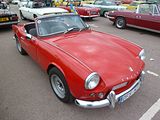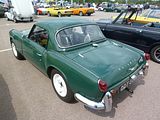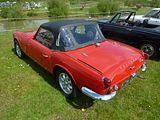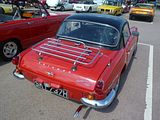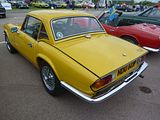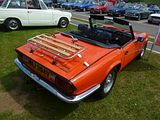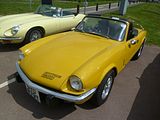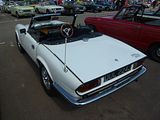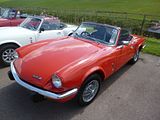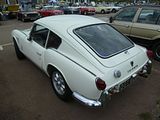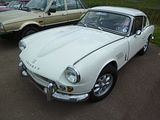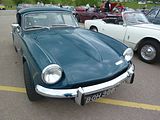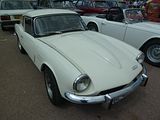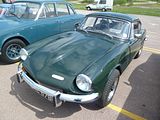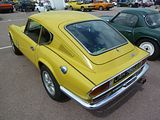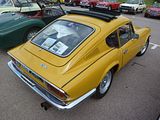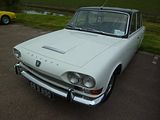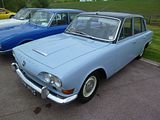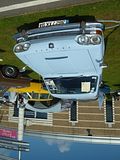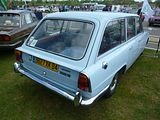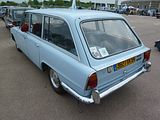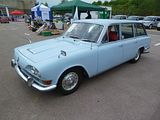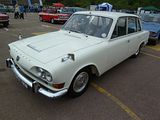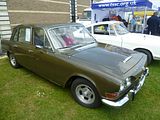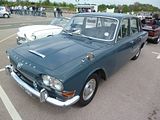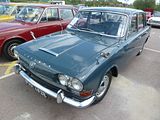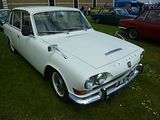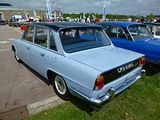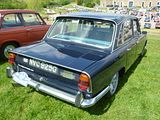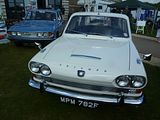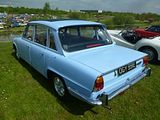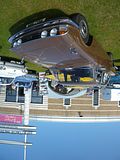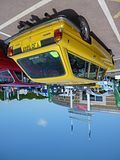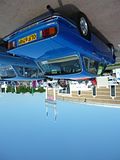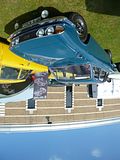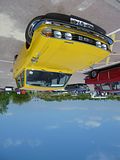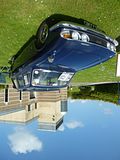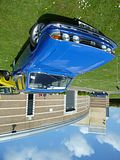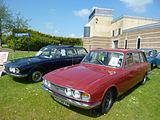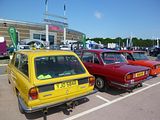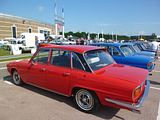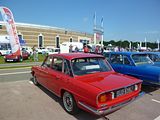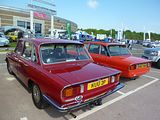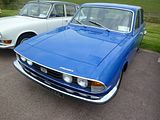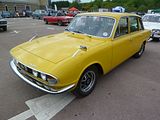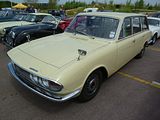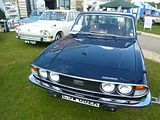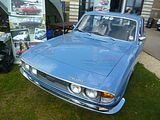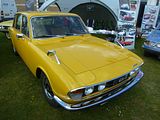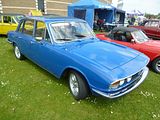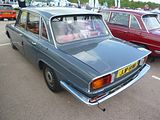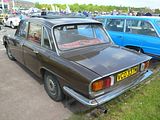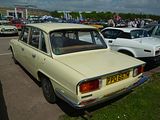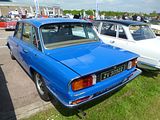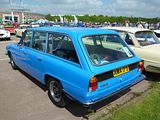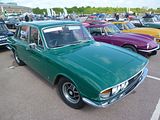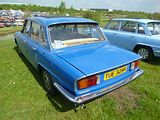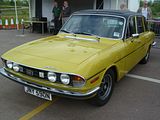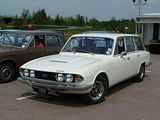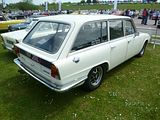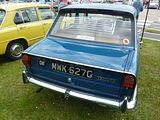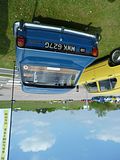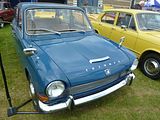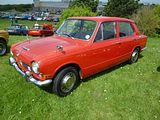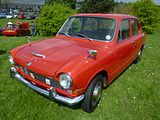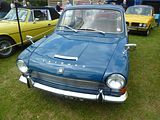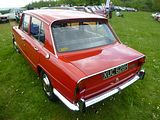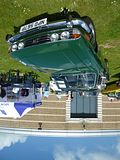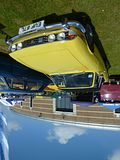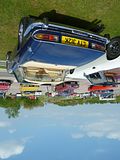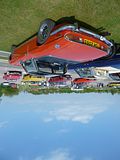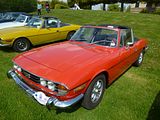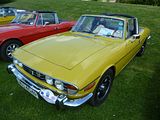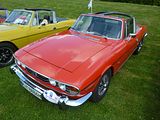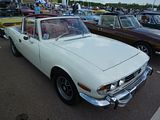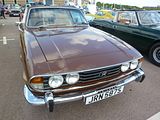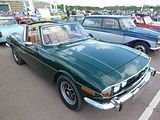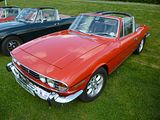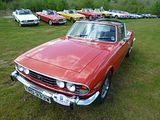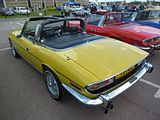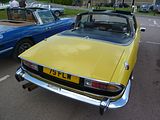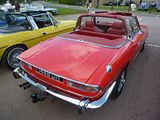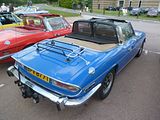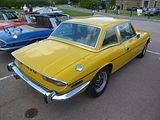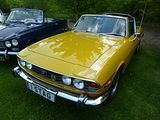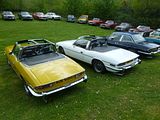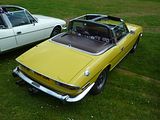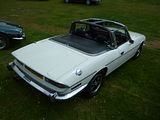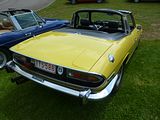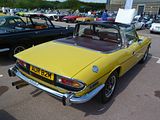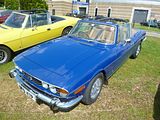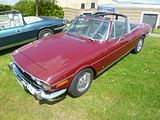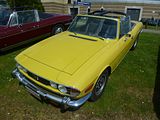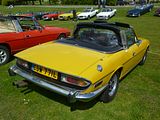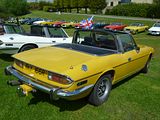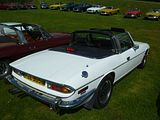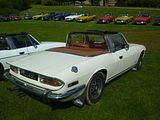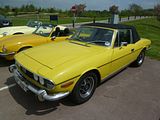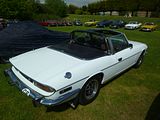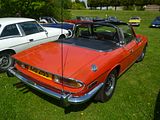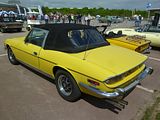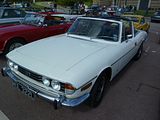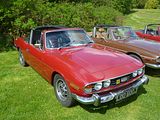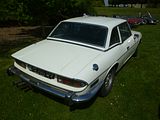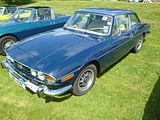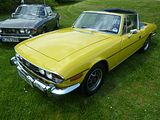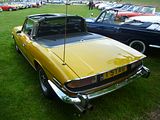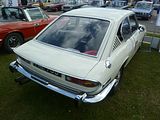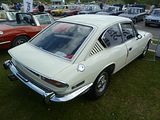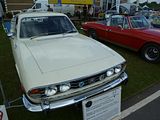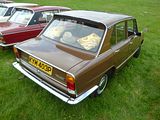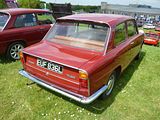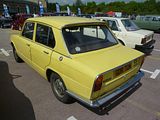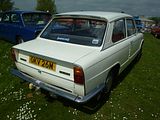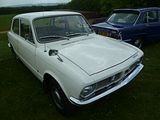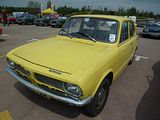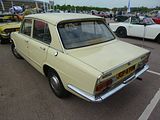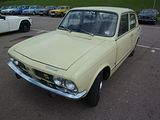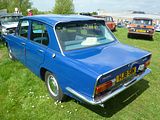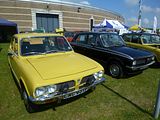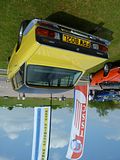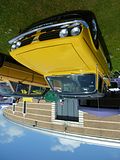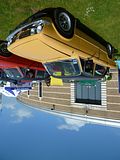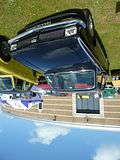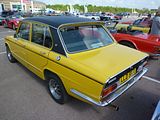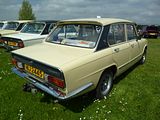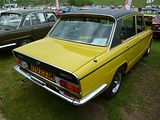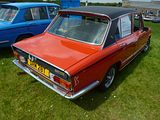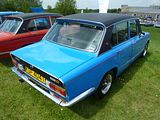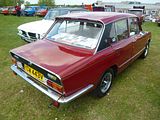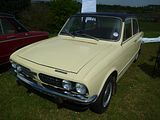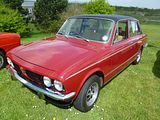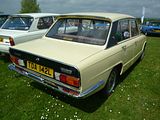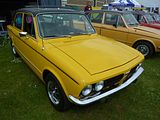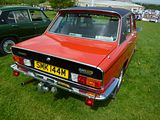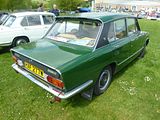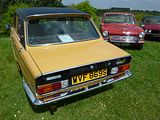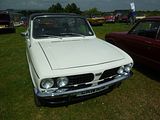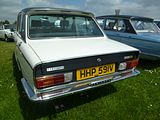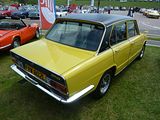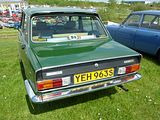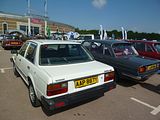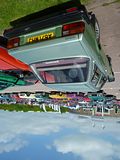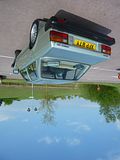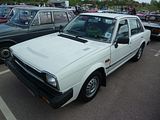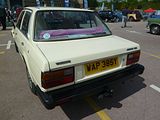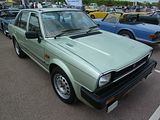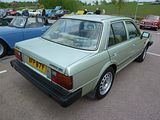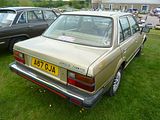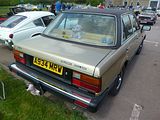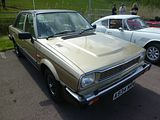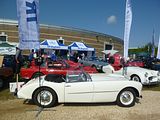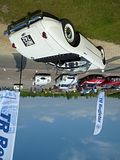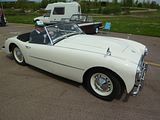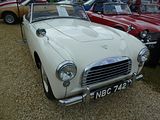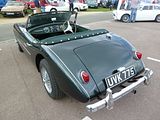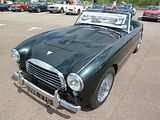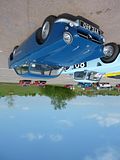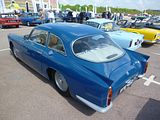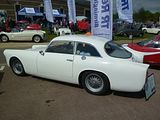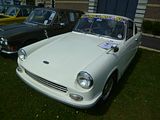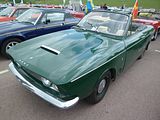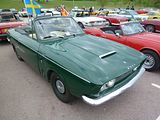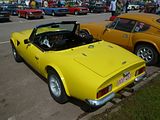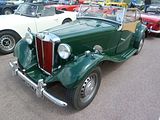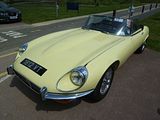Exactly three years ago, I enjoyed a particularly good day out at Prescott, in the company of several hundred owners of classic Triumph and Standard cars, who were there for their Spring Classic meeting. Cloudless skies on that memorable certainly helped, but off all the marques that come together in the BL/Austin-Rover stable, Triumph has long been my favourite with a wide variety of sporting saloons and true British sports car in the catalogue of models that they produced over the years, so the chance to wallow in nostalgia and see so many of these lovely cars proved particularly appealing. When I read that something more ambitious than that gathering was in plan for May 2013, the event which was christened STAR90 was an obvious choice to add to my 2013 diary. The plan for a weekend of activities centered around Gaydon was given added impetus by the fact that 2013 marks a whole series of anniversaries for the marque: 110 years since the foundation of Standard and 90 for Triumph, 80 years since the launch of the Triumph Gloria, 60 years for the Standard Eight and the start of Triumph TR production, 50 years of the Triumph 2000 and 40 years of the Dolomite Sprint. Enthusiastic owners from across Europe had started to arrive on Friday evening at a nearby hotel, and they had spent the Saturday either at Prodrive’s Proving Grounds or exploring the local countryside, and an evening Gala Dinner, and then the Sunday promised a vast gathering of cars outside the Gaydon Museum.
With a steadily improving weather forecast, which turned out to be somewhat pessimistic, as the day started and finished with almost cloudless skies, I headed up to Gaydon, to revel in this most British of marques. I arrived at 9:30am to find the car park in front of the museum already half full, and with displays on the grass and slopes above the site also well populated and noted that cars were arriving at a steady rate. By the time the show was officially opened at 10am, there were over 1000 cars on site, and it looked full, but still cars continued to arrive, as they did all morning. As well as the static display, an arena was set up and groups of cars were invited to park up whilst we were given a short discourse on the models displayed.
This was all led by the indefatigable Graham Robson, famous motoring journalist and author. Graham had worked in Triumph’s Competition Department in the 1960s, before he left to join Autocar magazine as a journalist, and although these days he drives a smart Jaguar XF, he is clearly as enthusiastic about the marque as ever. It was clear from what he said that the initial idea for the event – some 3 years ago – was his, and true to his word, there was no way that he was going to miss it. He did ask some of the individual club officials to help out with some of the details, but he is clearly one of those people who is like a walking wikipedia, with vast reserves of knowledge and anecdotes that would entertain for days at a time. His passion and enthusiasm for the marque was clearly a key contributor to its success, but his job was made easier by the amazing array of cars which were assembled. Here are the highlights:
PRE-WAR STANDARD
When people refer to Standard-Triumph, they tend to assume that Triumph bought the Standard Motor Company. This is the wrong way around. Standard is the older company of the two dating back 110 years. For most of their history they were the largest car manufacturer in Coventry, producing a vast number of models and indeed many different individual cars right through the 1930s. Sadly there were no Standards present from the first years of production as very few of these survive. The oldest models were a couple of the Kenilworth cars from 1914. Early Standards were named after places in the Coventry area and then when inspiration ran out, they used names from further afield.
Although the company continued to grow, with sales volumes rivalling Austin, it all started to go wrong in the late 1920s, with a failed export drive and disappointing sales of the larger cars in the range, which meant that by the the late 1920s, profits had decreased dramatically, so Standard decided to prune back the range significantly, ending up effectively with a single chassis, and the 9 hp engine. They did good business supplying this to coachbuilders such as Jensen and the Swallow car Company, which as we now know was the precursor to William Lyons’ SS Car Company later called Jaguar. It was at this time that a certain Captain John Black joined the company from Hillman, and he played an influential role for many years until his resignation in 1954. In 1930 before the worst of the depression, the Big Nine was introduced which together with the 6 cylinder Ensign and Envoy constituted the complete range. Standardisation was taken a step further with the bodies on 9 hp four cylinder and 15 hp six cylinder being almost indistinguishable except for bonnet length. The Big Nine was soon followed by the Big Twelve and sales for the second six months of 1931 exceeded those of the whole of the previous year.
In 1935, all production transferred to the Canley site, and by this time, Standard was the largest car company in a town which featured many other marques as well. Through the 1930s, Standard’s fortunes improved with new models, the Standard Nine and Standard Ten which addressed the low to mid range market and at the Motor Show of 1935 the new range of Flying Standards was announced with semi streamlined bodies. The Flying Standards came to the market in 1936 with their distinctive streamlined sloping rears virtually replacing the existing range of Nine, Twelve, Sixteen, and Twenty. The Flying Standards were so-called because of the major radiator design change, topped by the Union Flag badge apparently streaming backwards in contrast to its previous forward-facing position. Almost all the Flying Standards had 4 cylinders, but in 1938 two new factories were opened at Fletchampstead and Banner Lane, and a completely new engine was offered. This was a 20 hp V8 which made British history by pioneering independent front suspension on a mass-produced light car, A number of Standard models from this era were on show at the event, including a Ten, a couple of the mid 1930s Nines and several Twelves.
SUPER SEVEN
Although Triumph had been in business since 1885, initially importing bicycles and selling them under their own brand name and later in making their own cycles and from 1902, motorcycles as well, the first Triumph motor car did not appear until 1923. The 10/20 model was a clear response to the Austin Seven, launched the previous year. As production volumes of cars increased quickly in the 1920s, so models had to change and prices came down. Triumph were no exception, and by 1927 their product was called the Super Seven, an even clearer reference to what they thought was the principal competitor. Whereas the Austin was now being sold for £100, the Triumph was noticeably more expensive at £130, so sales never really challenged the Longbridge offering, and whilst you see lots of Austin Sevens at almost any event, the Triumphs are very rare, so it was a pleasure to come across a couple of these models, with their original fabric bodied cars on show.
GLORIA
By the early 1930s, it was clear that Triumph could not really compete against the likes of Austin, so a new strategy was conceived to offer larger and more costly cars instead. The result of this was the Gloria, which first appeared in 1933. It was offered with a bewildering array of different bodies, so at first glance you would be hard pressed to realise that these cars shared their underpinnings. There were several different models on show, all of them utterly splendid. My favourite, and an award winner of the day was this 1935 Free Flow model. This lovely body was originally made for a Bentley, but suits the smaller Triumph so perfectly. I first saw this car at the VSCC Prescott meeting in 2011 and was delighted to see it again.
I also loved this duo of saloon models.
There were a number of more sporting versions too, including a Southern Cross sports car.
DOLOMITE
In 1934, Donald Healey became the company’s Experimental Manager, and it was at this time that he acquired an Alfa-Romeo 8C2300. He decided to build his own equivalent., and the result was the Dolomite. Although the initial design did feature an 8 cylinder engine, the production models that ensued did not. Even so, these were very elegant designs and they drove quite nicely. The Roadster is probably the best known of this genre these days, with a particularly distinctive grille, but there were also saloon bodied models that bore the same name, which featured 4 and 6 cylinder engines. In 1937 the Vitesse name was first used by Triumph and there was a lovely example of this on show.
It was not enough, though as it seemed that Triumph was a spent force, declaring bankruptcy in 1939. The assets were purchased by TW Ward, but by the start of the Second World War, car production for pretty much all marques was interrupted. The remains of the company were bought by Standard in 1944, and as production resumed once hostilities had ceased, the chairman of the newly christened Standard-Triumph came up with a strategy to offer models using both brand names, and in Triumph’s case, all new models which were intended to compete against the Jaguar.
ROADSTER/2000
First new Triumph to appear after the war was this, the Roadster. As later became apparent, it was based on the 1800/Renown chassis, but with its own distinctive body style, built in aluminium as this material was far more readily available than steel. Made famous thanks to a starring role in Bergerac, this model is probably the last car ever offered with a “dickey” seat, making it a four seater for those occasions when more passenger accommodation was required. Like the saloon on which it was based, it evolved during its model cycle. All the cars on show had the later 2000 engine. Even so, this was never really a sports car, more of a tourer.
1800/RENOWN
The saloon offering quickly followed, sporting the very distinctive “razor edged” styling that was favoured by Sir John Black. Like so many cars, there is more to this range than meets the eye. I had always thought of this design, produced from 1946 until 1954, as the Renown, but in fact the first cars were called the 1800 Town and Country. A couple of years following the launch, the car was modified extensively to take the Standard Vanguard chassis, and that car’s 2.1 litre engine was fitted, though the external appearance changed little, and then in 1949 the Renown name was introduced. The latest of the four cars on show had yet more changes, with a larger rear window being the most discernible difference. These large cars were in no way a sporting drive, and so not really a rival to the similarly priced Riley RM, let alone the contemporary Jaguar initially in Black’s sights, but as a relaxed cruiser that was nicely finished, the Renown had its appeal when new as it does now.
MAYFLOWER
Looking very much like a smaller Renown, the Mayflower was a much smaller car, with an engine that was not really meaty enough to propel the monocoque body with any alacrity. Even when new, the styling polarised opinion, and sales were modest, with 35,000 cars made over a 4 year period, of which a handful were Dropheads. They are rare now, so to spot four in one day was pretty unusual.
VANGUARD
An important car not just for Standard, but also for generating significant export revenue, the Vanguard was first launched in 1948, the first all new British design produced after the war, and which replaced all the pre-war models which had been made again sine 1946. The fastback styling of the first models aped American designs of the era leaving little doubt where it was intended to sell the car. As well as the fastback saloon and estate models, a pick-up was offered for the Australian market. Two examples were on show. Neither was totally original, both having been produced by combining parts from donor cars, but the results were impressive with the model sporting a crane in the back attracting a cast amount of attention.
The third phase Vanguard, featuring styling by the Italian Vignale styling house was launched in 1955 in saloon and estate format. Among the variants that were offered in an eight year model run were the Sportsman, which did particularly badly in the market selling less than 1000 cars. So there was much excitement among the cognoscenti when it was revealed that there was one present.
EIGHT/TEN/PENNANT
Replacing the Mayflower, the Eight made its debut in 1953, and it was an all new design, with a particularly significant engine, the 28 bhp 803cc “Small Car” unit, which went on to survive to the end of Triumph production in 1981 in the 1496cc engined Spitfire. Reflecting a society that was still getting recovering from the costs of war, and the fact that its predecessor had failed in its quest to sell as an upmarket small car, the Eight was deliberately basic, lacking even such items as an external opening for the boot, let alone a heater. At £481 at launch, it was the cheapest four door car on the market at the time. A slightly less spartan and more powerful model, the Ten joined it in 1954, and this in turn was replaced by the Pennant in 1957. With extended rear wings, and two tone paintwork, this model did look different, even though it was only ever intended to be a stop gap until something far more modern was ready. There were examples of all three models on show.
In the 1950s, estate cars were regarded as largely being the preserve of the commercial traveller for whom luxury certainly did not seem to matter. Standard adapted their small car to produce the Companion, which was unusual among its competitors for having four passenger doors. This is one of very few survivors indeed and is the same car that featured in Classic & Sports Car magazine about 3 years ago.
TR
During the same year that the Eight was introduced, another car was displayed at the London Motor Show. This was a sports two-seater, intended to compete directly with MG, which had a modified Standard Eight chassis and a Vanguard 2 litre engine in it. Its serious lack of luggage space, however, resulted in production being delayed until the following year when the tail was restyled to incorporate a generous boot. The car was badged as a ‘Triumph’ rather than a ‘Standard’ and the TR2 was a instant winner, in particular with the Americans. Ken Richardson achieved 124 mph. on the Jabbeke Highway in Belgium in a slightly modified car. As a result of the publicity, history repeated itself and small manufacturers again came to the Standard Motor Company for engines etc. including Morgan, Peerless, Swallow, and Doretti. There were examples of many of these cars at the event. The TR itself then went through a program of constant evolution over the next 27 years, by which time the body styling had been changed 3 times. A full range of every type of TR model was on show, and examples of all variants were gathered together into the arena for what we were told was a sight never seen before.
The TR Register own TS2, the first ever right hand drive prototype TR, which was first shown in 1953 and very close in all but details to the production TR2 which finally arrived in 1954. Restored 10 years ago, this vehicle has now covered a further 50,000 miles, and although a few modifications have been in the interests of driveability (such as an electric fan), it looks exactly as it did 60 years ago.
As well as the TS2, there were a number of the production TR2 models on show.
The TR3 was launched in 1955, and represented a steady evolution of the TR2, with more power and a redesigned grille as well as the option of a hardtop. Further updates resulted in cars known as the TR3A, revealed in 1957 and the TR3B in 1962, by which time the TR4 had already gone on sale. The TR3B was the response to dealers who feared that the very different TR4 would not necessarily command the same support as the earlier car.
An ambitious plan to combine the attractions of Italian styling and British Sports Car pedigree was conceived, with the intent of building at least 1000 cars, with styling by Michelotti, and which would be built in Italy by Vignale. The elegant result of this venture appeared in 1959 and was called the Italia 2000. Never part of the official Triumph range, the venture was dealt a fatal blow when, following Standard-Triumph’s purchase by Leyland Motors in 1961, the company decided to put all its efforts into the then forthcoming TR4. In the end, just 329 cars were built, all but 6 of them with left hand drive. They are even more rare now, with only about 3 being known to be resident in the UK, one of them in the Coventry Museum, so it was a real delight to see one present at this event. It had been brought over from France, a trip made extra worthwhile when it was accoladed as the Car of the Event, which pleased its owners more than somewhat.
The TR4 first appeared in 1961 and sported a completely new body, designed by Michelotti. The car later evolved into the TR4A, which featured independent rear suspension. As well as several road cars, one of the factory works car was also present.
The Dove was a low volume version, created for the Dove dealership in Wimbledon by the same specialist coachbuilder, Harrington, who also added a fastback to the the Sunbeam Alpine. They were built to order, which means that each car is slightly different, and they were expensive, costing as much as a contemporary Jaguar E type. Accordingly, just 43 cars were produced, of which it is estimated that 12 survive so,to get 2 of them in the same place, even at an event like this is quite special.
Replacement for the TR4 was called TR5 in the UK, and this was the first British car with Fuel Injection, the troublesome Lucas system. Export model cars were called TR250, and there were examples of both on show.
The TR5 had a short life, as a restyle by Karmann gave rise to the TR6, premiered in early 1969. My favourite of the TRs, this car has real appeal with its simple lines, and potent 6 cylinder engine.
Final design was the controversial Harris Mann styled TR7. Initially decried, this model is now seen very much as part of the TR family and with 115,000 cars made over a 7 ear life, more TR7 s were made than any other TR. As well as mix of standard TR7 Coupe and Convertible models, there were a number of V8 engined cars, some of which were genuine factory cars and some were later conversions. Also on display were a couple of TR7 Sprints. In 1977 it is understood that 62 cars were made with the 16 valve Dolomite Sprint engine under the bonnet. The owners of both of the cars – both of which happened to be Pageant Blue – apparently own another example each. One of the factory TR8 rally cars was also present.
Final TR model was this, a Grinnall, which was based on TR7 componentry, but with a body style showing how the car could have evolved into the 1980s.
HERALD/VITESSE
Replacing the small Standard Eight/Ten/Pennant models, the Herald made its debut in 1959, competing for attention at the Earls Court Show that year with the Mini and the Ford Anglia. Carrying over much of the componentry of the old Standards, it was the first of what turned out to be a strong relationship with Italian stylist Michelotti. Somewhat unusually, the Herald featured a separate chassis, which meant that the whole front of the body could be lifted to give access to the engine, and with its standard independent rear springs, it rode well and with its direct rack and pinion steering, had great manoeuverability to rival the legendary London taxi. It enjoyed enjoyed almost instant success and quickly became especially popular among lady drivers. The saloon model was quickly joined by a short lived Coupe, whilst the Convertible and Estate models remained in the range until the end of production in 1971. Early cars were not exactly fast, with the 948cc engine, but over time larger versions of the Small Car engine that had featured in the Standard 8 appeared, with the 1296cc unit in the 13/60 endowing the car with decent performance for its day. Over 500,000 were made.
In 1962, Triumph launched the Vitesse, a more overtly sporting version of the car, which combined the Herald body, albeit with a new front end headlight layout with the class unique smoothness of a 6 cylinder engine, a 1600cc version of the unit that was more often found under the bonnet of the Vanguard Six. The trim quality was upgraded over standard Herald models as well. Handling of the first cars, only ever offered in saloon and convertible guise, with their swing axle suspension was not a strong feature (!), but the rear suspension was sorted and by the time the Mark 2 cars arrived in 1967 with their 2 litre engines, this was a desirable product with no truly direct competitor in the market place. Survival rates of the Vitesse, especially the 2 litre cars are quite high, and the cars are much in demand.
Between 1962 and 1966, a small number of Van models were made as well, which went under the Triumph Courier name, and there was a beautifully restored example on show.
SPITFIRE
The Spitfire was launched in 1962, Trumph’s direct riposte to the MG Midget and Austin-Healey Sprite twins which would become in house rivals a few years later. Opinions are still deeply divided as to which is the better car, with strong support for each. Four generations of the same basic design were produced, with the Mark IV evolving into the 1500 model in 1974, and with the longest production life, it is no surprise that there are far more of these cars extant than of the earlier generations.
GT6
Just as MG put a coupe style roof on the MGB, so Triumph did on the smaller Spitfire, creating the GT6. For further differentiation, they installed the Vitesse’s 6 cylinder engine, to endow the car with better performance. Handling of the first cars was interesting, to say the least, but they sorted it fairly quickly, and the body style then evolved in parallel with the Spitfire, though the model was deleted in 1973, meaning that this car is far rarer than its open top stable mate.
2000/2500
Another car with an anniversary, this one being for 50 years. The Chairman of the 2000/2500 Owners Club led the commentary when these cars came into the display arena. He noted that when the club was founded, they had over 2500 members, but now, some 25 years later they are down to about 1000 members. but the quality of the cars has increased, and the standard of those on show certainly bore out his comments, as all of them were very nicely turned out indeed. When new., this car was always compared with the Rover 2000, which launched at the same times. The press always tended to prefer the Rover, but the reality is that the Triumph sold in greater quantity. That could partly be down to the fact that the Rover was always a strict 4 seater, whereas the Triumph was roomier with 5 seats and a larger boot. The Mark 1 range went through a steady program of evolution, with an Estate model added in 1965 and the Fuel Injected 2.5 PI arriving in 1967. Survivors are quite rare now, so it was good to see not just a particularly well kept 2000 saloon (which won “best post war saloon”), but also a PI and a French plated Estate model.
The facelifted model appeared in 1969, and there were several of these cars shows on display, with the very rare 1974 model 2500 among them. This was a short running car withy 2 SU carburettors in place of the troublesome Lucas Fuel Injection of the PI which was quickly replaced with the more potent 2500TC which had larger carbs and hence more power. The 2500S came in 1975 and was the top of the range car until the model’s replacement by the Rover SD1 in 1977.
The Chairman’s own car turned out to be something rather special, Looking outwardly no different from a 2500S, this is one of just 3 saloons and 25 estates that had the Stag V8 engine under the bonnet. This is the only surviving saloon. That V8 engine is a neat fit, and you have to wonder why Triumph did not offer this as a factory model, though I guess the answer is that the resulting model would have been seen as too close a competitor for the Rover 3500S. It did sound good though when he fired the car up.
Also rather special is this Estate car. This one is fitted with the FF four wheel drive system and Maxaret anti-lock brakes. The car was rescued from the Isle of Man where it was discovered in a particularly decrepit state, but now looks immaculate.
1300
Originally conceived to replace the Herald, the 1300, which was launched at the Earls Court Show in 1965 ended up sitting above that car in Triumph’s range. With styling copied on the larger 2000, but a combination of the still uncommonly encountered front wheel drive and a quality of trim that was far better than anything other than a Vanden Plas 1300 (the carpet extended up around the gearlever, for instance!), the 1300 had a niche all to itself in the market. It turned out not to be that large a niche, as the market was not really ready for what we would now think of as a premium model, although the addition of a faster TC model, with twin carburettors did boost sales a bit. You don’t often see 1300 at classic events these days, so it was nice to find quite a few at this event.
STAG
This event coincided with the European Stag Owners 2013 gathering, and that meant that there were in excess of 60 Stags present, boosting the total number of cars on show quite considerably. Although a lot of them were UK registered, I spotted Stags from France, Belgium, Holland, Germany and Switzerland as well. Hats off to Lesley Phillips for bringing all these cars together, and in their distinctive 1970s BL paint jobs, what a colour sight they made.
Whilst I do like the Stag as we know, I have to say that my favourite model was the one that BL never made, the prototype Fastback. History records that Michelotti made 2 prototypes in 1970 and they both reached the UK and somehow ended up being scrapped. The car that survives is one built by triumph themselves, and when you look at it, you have to wonder why they never put it into production, as it just looks so “right”. Sadly, though, they did not, but this beautifully restored car remains for us to wonder “if only…” The owner, a spritely 87 years old, was interviewed and he said that it will pass down his family to ensure that this unique car survives. Bravo!
TOLEDO
As one of two replacements for the front wheel drive 1300, the rear wheel drive Toledo debuted in autumn 1970, initially just as a 2 door saloon. It was intended to be a cheaper car, and lacked some of the features of its predecessor. A 4 door model arrived in 1971 and gradually the specification was improved. The Toledo ran until 1976 when it was replaced by the Dolomite 1300, and during this 5.5 year life, it sold quite well to those who wanted a small family saloon that was far better trimmed and finished than an Escort or Viva. There were several examples on show, in both 2 and 4 door form.
1500
Initially retaining the front wheel drive of its predecessor 1300, but with a longer body which improved the boot space that was later adopted by the Dolomite, the 1500 was re-engineered in 1973 and converted to rear wheel drive format, to create the 1500TC. Survivors are rare and there were only a couple of cars on show.
DOLOMITE
The Dolomite first appeared in 1972, and with its 1850cc engine and lively performance, this was a sports saloon that should have sold even more strongly than it did. Early reliability issues were combined with an inability to build them fast enough to meet demand. The problems were compounded in 1973 when the Sprint model arrived. With its 16 valve 2 litre engine, this car boasted very impressive performance and a quality of interior trim that was a potential world beater, but as so often happened with BL cars in the 1970s, insufficient testing and cost cutting in some areas meant that the car never achieved its full potential. With quality issues now all resolved, a good example of either the 1850 or the Sprint makes an excellent and very useable classic car now, and the popularity was evidenced by the large number of cars on show. In 1976 the Toledo and 1500 models were incorporated into the Dolomite family, with the former abandoning its own bodyshell in favour of the better balanced Dolomite design. The Dolomite Owners Club had 58 cars on display and there were several more in the general part of the event as well. There was even one example of the limited edition SE model, a car which featured the single headlight design of the basic 1500, all of which were painted in black.
ACCLAIM
Last ever design to bear the Triumph badge was the Acclaim, a car which was based on the Honda Ballade and produced in a hurry as Triumph desperately needed new product for the 1980s. The car had a three year life, and was only offered as a 1335cc engined saloon with a choice of manual or Triomatic transmissions and in three trim levels. Never really seen as a true successor to the Dolomite, it enjoyed modest success when new, with just over 133,000 built. It is now a rare sight. There were a few on show here, though.
There was a limited edition Avon Acclaim that had leather seats with piping to match the body colour, leather door panels, wooden and leather trimmed dashboard, wooden door cappings, two-tone metallic paint, colour-coded wheels with chrome embellishers, chrome-plated grille, colour-coded headlamp surrounds, vinyl roof and extra soundproofing. There was also an Avon Turbo, which had Lunar alloy wheels with 205/60 tyres, suede upholstery, front air dam, and side decals. A Turbo Technics turbo increased the engine’s power output from the standard 70 bhp to 105 bhp. It is thought that there are only four surviving Avon Turbos including the press car (VWK689X), which was the first Avon Turbo. There was one of these on show.
TRIUMPH-BASED CARS
Over the years, Triumph components were used for some very distinctive looking models. None more so than the Swallow Doretti, a lovely sports car offered in 1954/55, based on the TR2. A couple of these cars were on show.
Peerless built a four seater coupe on the TR3 chassis from 1960, and there were a couple of these on display.
Bond used the Herald/Vitesse chassis for their sports car in the 1960, the Equipe and there was an early GT model as well as one of the later 2000 Convertibles on show.
This later kit car was badged Hurricane. I would guess that it was based on a Spitfire.
OTHERS
A few non Triumph cars managed to sneak into the main display area, of which this MG TD and a lovely Series 3 Jaguar E Type were the most notable.
This was a remarkable event. It is clear from remarks made by Graham Robson in his closing speech that not only had it taken a lot of organising, to get quite some many cars form quite such a wide area to attend, but there had been a number of political difference between the various Owners Clubs which had at least for one weekend been cast asunder. I have to say that the result was so worthwhile, with a display the like of which we may not see again, perhaps for another 10 years when all those anniversaries occur again.


